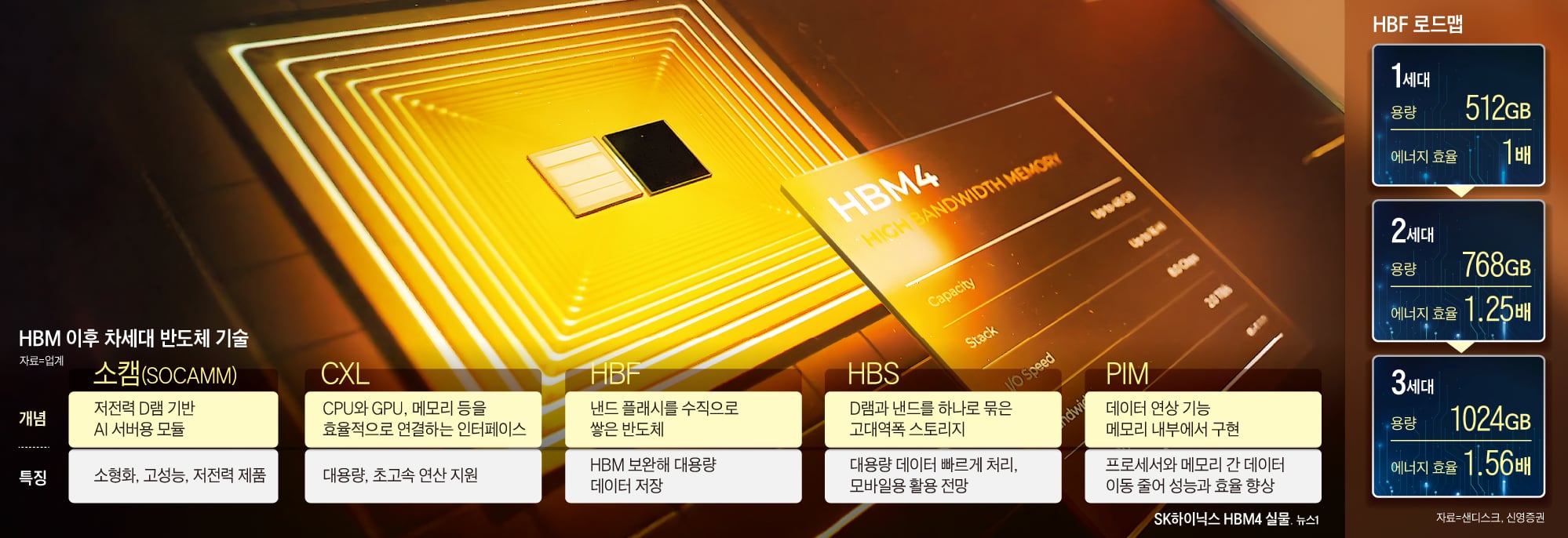The semiconductor sector is concentrating on creating advanced technologies that will continue the legacy of HBM (High Bandwidth Memory). Wi...
The semiconductor sector is concentrating on creating advanced technologies that will continue the legacy of HBM (High Bandwidth Memory). With the arrival of the AI (artificial intelligence) era, solutions capable of handling greater data volumes at higher speeds have become essential. HBM, which is made by stacking several layers of DRAM, has quickly gained prominence due to its ability to efficiently manage the rapid expansion of AI services and data. Nevertheless, HBM alone is now finding it difficult to satisfy the demands of AI. There is a need for technologies that use less power while storing and processing larger amounts of data.
**◇Low-Power, High-Capacity Product Development**
One of the most prominent next-generation technologies in the semiconductor field is SOCAMM (Small Outline Compression Attached Memory Module). SOCAMM is a memory module designed specifically for AI servers utilizing low-power DRAM. It stands out for its energy efficiency, as it integrates several LPDDRs (low-power DRAMs). NVIDIA, a worldwide pioneer in AI, is anticipated to incorporate SOCAMM into its upcoming AI accelerator, "Rubin."

Semiconductor firms are concentrating on SOCAMM as power usage is expected to become the primary limitation in the AI era. Despite superior performance, excessive power consumption poses challenges for market adoption. Micron has recently introduced SOCAMM2, which boosts energy efficiency by 20%, while Samsung Electronics and SK Hynix are also working on SOCAMM with improved power efficiency.
CXL (Compute Express Link), a technology aimed at addressing bottlenecks caused by AI's growing need for processing vast amounts of data, is also attracting significant attention. Previously, memory was connected to CPUs (central processing units) or GPUs (graphics processing units) to manage computations, but current data capacity limits have been reached. CXL enables memory to be connected to CPUs or GPUs in a shared pool, making it available as needed. In theory, memory capacity can be expanded without limits, and it is efficient because it can be utilized flexibly when required. Samsung Electronics has finalized mass production preparations for CXL 2.0-based DRAM, while SK Hynix has created a CXL 2.0-based DRAM solution that offers 50% more capacity than existing DDR5 modules. Domestic startups like Panmnesia and Primemass are also working on CXL technology.
**◇ Rise of HBF as a Complement to HBM **
Another initiative aims to substitute HBM, which has seen a significant increase in value during the AI era. This alternative is called HBF (High Bandwidth Flash). Unlike HBM, which is a high-performance chip made by stacking DRAM layers, HBF utilizes NAND flash instead of DRAM.
Typically, DRAM functions like a "workbench" for rapid data processing, whereas NAND acts as a "warehouse" for long-term data storage. Unlike DRAM, NAND can maintain data even without power. As artificial intelligence demands ever-larger datasets, semiconductors that surpass HBM's processing capabilities are becoming necessary, and HBF is seen as a solution to this need. HBF can accommodate more layers than HBM and is designed for efficiently handling large-scale data. According to Shinyoung Securities, HBF is anticipated to enter the market around 2027, with the market size projected to reach 12 billion dollars (about 1.76 trillion South Korean won) by 2030. Professor Kim Jeong-ho from KAIST stated, "HBF is not intended to replace HBM but is expected to develop in conjunction with it in a complementary manner."
A concept known as HBS (High Bandwidth Storage) has also come into existence, taking things a step further. It is a high-performance semiconductor that combines DRAM and NAND in a stacked configuration. By leveraging the strengths of both DRAM and NAND, SK Hynix is reportedly working on this technology for use in mobile devices.
Processing-in-Memory (PIM) technology is also experiencing steady progress. PIM refers to a type of semiconductor that can handle both data storage and processing at the same time, thereby improving AI performance, which involves intricate computations. Samsung Electronics is focusing on "PIM semiconductors" as future AI chips, while SK Hynix is working on PIM based on LPDDR6. A representative from the semiconductor industry stated, "In the AI era, memory and system semiconductors are merging. Future technologies will increasingly make the distinction between memory and system semiconductors less clear."



